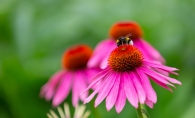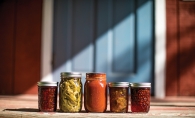
As you approach the Straate home, you can’t help but notice the two-tier fountain, front and center of the brown brick two-story home. All four windows on the second floor sport window boxes filled with colorful trailing begonias and greenery. Trees mark the north boundary with shade-loving plants underneath their boughs.
On either side of the fountain, long gardens reach out like welcoming arms.
But it didn’t start that way. When master gardener Diana Straate, her husband and two sons moved into the house in 2003, two things needed immediate attention: the septic system in back and rotting trees leaning eastward in the front yard. The couple cut down the trees and expanded their garden—an acre and a half of it.
Putting in a new septic system created a five-foot high by 30-foot wide mound in the backyard. They covered it with dirt and, following the theme in the front yard, topped it with grass. To camouflage it, Straate planted clusters of small bushes, mostly weigela (an Asian bush with small flowers) and began adding more plants. She kept adding in the backyard and didn’t spend much time in the front until eight years later.
Her style of gardening is country cottage. This means she includes older flowers her mother and grandmother would have known. The garden is “free flow”—the plants don’t have to stay in a straight row or round circle.
“You will not see perfection here,” Straate says. “I let nature assist with some of my gardening decisions.”
Straates has been gardening since she was able to walk. When she lived next to her grandparents as a preschooler, she could often be found sitting on the ground in their garden, eating peas directly from the pods.
“I can’t think of a time I didn’t have some sort of garden,” she says.
Every morning Straate walks the loop around her gardens, just as she did with her grandparents in their garden. Of her own daily walk she says, “Sometimes I feel the presence of my grandmother with her Czech accent or my mother who never had the chance to see my little slice of heaven.”
Almost all her garden plants are self-seeding annuals, perennials (plants that come up every year on their own) or plants for pollinators. The exception is the 100-plus begonias she overwinters in her basement; most of which are at least 3 years old. “I have a 7-year-old tuber that I just dug this year,” she says. “It measured 15 inches by 12 inches by 9 inches.” Gardening doesn’t stop when the first freeze sets in. Winter is a time for watching the health of plants as they lie dormant.
“Late January and February, I check my [stored] tubers to make sure they are in good shape and give them a little spritz of water if it is unusually cold outside and drier in the house,” Straate says. It’s the time she loves to catch up on stockpiled garden magazines and do a bit of internet research, planning for the coming planting season.
Each year she tries two new herbs and at least two new varieties of veggies and several new flower seeds. So, the winter months allow time to tag selections in seed catalogs.
Straate is also a seed saver. She gathers and lets flower heads dry thoroughly then collects the seeds. “February is a good time to package up my seeds,” she says.
Straate chooses self-seeding annuals like salvia with its purple spikes; calendula, whose flower looks like a cross between zinnia and coneflower, but is a self-seeding medicinal herb. Its oil can help heal scrapes and cuts. And, verbena, which attracts butterflies and hummingbirds.
July is the most colorful time for her garden, but September still holds its own with yellows and oranges, purples and whites. Other plants include astilbe with its tall, feathery foliage; heuchera (coral bells), where the colored leaves are the highlight; the popular butterfly weed; and gaillardia, a daisy-like plant, red in the middle with yellow tips.
Walking along a rock path around the side of the house you see ornaments—not Christmas balls, but pieces found at garage sales, flea markets, gifts from friends and from the farm where Straate’s husband grew up. You might spy a metal rooster or wooden archway, or a couple of round metal hoops from the farm.
The backyard has a fountain as well, a pond and cottage gardens similar to the front yard. The larger pond was not in the original plan, but her sons kept insisting until she gave in and now she loves it.
“First the pond and small waterfall, then the fountain and fish, then aquatics, and, you guessed it—it was too small,” she says. Her husband helped expand it, cutting through 5-inch tree roots. The slope of the backyard septic tank covered in grass was perfect for the waterfall.
“I love when our boys would come home from school and head straight out to the pond,” she says. During their school years she would sometimes look out the window to see a lineup of boys looking into the pond as if they were staring into a deep hole. She chose those times to feed the fish—an excuse to catch bits of their conversation.
Ever family oriented, a screened porch was added to the back patio as a gathering place. “We call it ‘the resort,’” she says. Here the Straates spend endless hours listening to the water, watching and documenting birds at the feeders and enjoying the flowers and wildlife.
Beyond the septic tank, on top of a peat bog that is part of the Elm Creek watershed, sits the Straate vegetable garden surrounded by a 4-foot-tall fence, to deter critters.
“It’s the only flat space that has a full day of sun,” Straate says.
A compost bin sits at the outer edge and her husband tills leaves and organic matter into the patch every fall. A white greenhouse stands nearby for starting plants.
Although it’s February Straate has a clear image of June—time to pick some radishes, lettuce, spinach and endive for a salad. Carry them up the hill in a bowl. Take a quick peek at the koi. Appreciate the blooming iris and bachelor buttons. Walk around to the front for a last glimpse of forget-me-nots, columbine and wild geraniums before heading in for dinner.









